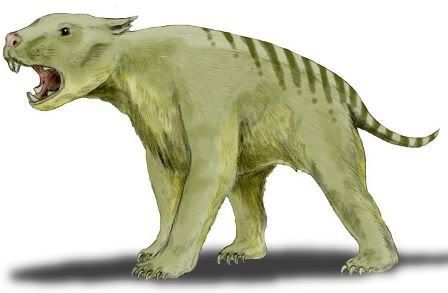Post by bluefedish on Jan 22, 2008 1:43:10 GMT -5
The Marsupial Lion (Thylacoleo carnifex, meaning "meat-cutting marsupial lion") is an extinct species of carnivorous marsupial mammal that lived in Australia from the late Pliocene to the late Pleistocene (1,600,000–40,000 years ago).
Description
The Marsupial Lion is the largest meat-eating mammal to have lived in Australia, and one of the largest marsupial carnivores the world has ever seen. It would have hunted animals - including the giant Diprotodon - in the forests, woodlands, shrublands and river valleys, as well as around waterholes.
The closest living relatives of this fierce carnivore are the plant-eating Wombats and Koala. Pound for pound, it had the strongest bite of any mammal species living or extinct; a 100 kg (220 lb) individual had a bite comparable to that of a 250 kg (550 lb) African Lion and is thought to have hunted large animals such as diprotodonts and giant kangaroos. It was the most specialised marsupial carnivore to have ever existed and had extremely strong forelimbs, with retractable claws, a trait previously unseen in marsupials. It was also armed with sharp carnassial teeth that could tear large chunks of meat off its prey, powered by very strong jaw muscles. Its strong forelimbs, retracting claws and incredibly powerful jaws mean that it may have been possible for it to climb trees and perhaps to carry carcasses to keep the kill for itself (similar to the leopard today).
The Marsupial Lions were 75 cm (29 in) at the shoulder and about 150 cm (75 in) long from head to tail. They averaged 101 to 130 kg (223 to 287 lb), and individuals reaching 124 to 160 kg (273 to 353 lb) were common. They are quite comparable to female lions and tigers in general size.
Fossils
Fossils of the Marsupial Lion have been found at many sites in Australia. Whole skeletons and skulls have been found such as those discovered in a limestone cave under Nullarbor Plain in 2007 where it is believed the animal fell to its death through a narrow opening in the plain above. One adult Marsupial Lion was found with a very young baby that would still have been in its mother's pouch.

Selected Source:
en.wikipedia.org/wiki/Marsupial_Lion
Description
The Marsupial Lion is the largest meat-eating mammal to have lived in Australia, and one of the largest marsupial carnivores the world has ever seen. It would have hunted animals - including the giant Diprotodon - in the forests, woodlands, shrublands and river valleys, as well as around waterholes.
The closest living relatives of this fierce carnivore are the plant-eating Wombats and Koala. Pound for pound, it had the strongest bite of any mammal species living or extinct; a 100 kg (220 lb) individual had a bite comparable to that of a 250 kg (550 lb) African Lion and is thought to have hunted large animals such as diprotodonts and giant kangaroos. It was the most specialised marsupial carnivore to have ever existed and had extremely strong forelimbs, with retractable claws, a trait previously unseen in marsupials. It was also armed with sharp carnassial teeth that could tear large chunks of meat off its prey, powered by very strong jaw muscles. Its strong forelimbs, retracting claws and incredibly powerful jaws mean that it may have been possible for it to climb trees and perhaps to carry carcasses to keep the kill for itself (similar to the leopard today).
The Marsupial Lions were 75 cm (29 in) at the shoulder and about 150 cm (75 in) long from head to tail. They averaged 101 to 130 kg (223 to 287 lb), and individuals reaching 124 to 160 kg (273 to 353 lb) were common. They are quite comparable to female lions and tigers in general size.
Fossils
Fossils of the Marsupial Lion have been found at many sites in Australia. Whole skeletons and skulls have been found such as those discovered in a limestone cave under Nullarbor Plain in 2007 where it is believed the animal fell to its death through a narrow opening in the plain above. One adult Marsupial Lion was found with a very young baby that would still have been in its mother's pouch.

Selected Source:
en.wikipedia.org/wiki/Marsupial_Lion



